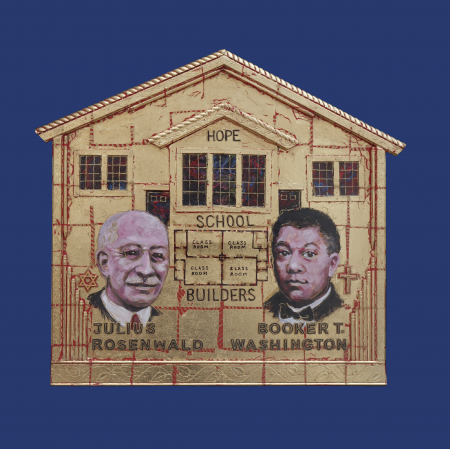Booker T. Washington, born into slavery, became a stalwart advocate for the advancement of access and equity for Blacks in America through education. Julius Rosenwald, the son of Jewish immigrants from Russia, grew in wealth as president of Sears and Roebuck. He too believed in the value of education as a tool for African-Americans to overcome the disadvantages of slavery. Through a deep and loving friendship, together they developed a method for building schools for Black children which resulted in the construction of 5,000 schools in the rural South.
Washington was one of the most widely known Blacks in America following the Civil War. Born in the 1850s on a Virginia plantation, he and his family survived the degradation, poverty and hunger that many enslaved people experienced in the South. After Emancipation his family moved to West Virginia where Booker was able to attend a small school for Black children. His passion for learning was observed while working for a prominent white family. They encouraged him to attend the Hampton Institute which had been founded in Virginia after the Civil War for the education of Black people. There he excelled and after graduation he was appointed to a teaching position by the school’s founder, a former Union Army General Samuel Chapman Armstrong. In 1881, Armstrong received a request to recommend a “well qualified white man” to become the principal of a school being founded for the “training of Negro teachers”. Armstrong recommended Washington whom he described as a “very competent, capable mulat-to… I know of no white man who could do better.” He was hired and under his leadership Tuskegee Institute gained its reputation as an outstanding educational college.
On a trip to Chicago, Washington asked the head of the YMCA if he knew a wealthy person who might serve
on the board of Tuskegee. Julius Rosenwald was recommended and Washington met him when they both spoke at the annual Chicago YMCA dinner in 1911. Rosenwald grew up in Springfield, Illinois. After his parents fled to the
U.S. from Russia, Julius followed his father’s trade as a peddler. At 16, he went to New York to apprentice in the clothier business with an uncle. He returned to Illinois and began a business with some other family members. Before long, he became president of Sears and Roebuck, a profitable mail order business. Rosenwald gained a reputation in business as an innovative thinker as well as a wealthy man interested in contributing to charitable organizations. Rosenwald and Washington would seem to have lived in two different worlds, but Rosenwald learned from his family’s pain of persecution as a result of antisemitism in Russia, noting: “I belong to a race that in times gone by did not have a fair chance in life. I feel particular sympathy for the Black race which does not have a fair chance under the existing conditions of American life.”
Through his role on the Tuskegee board, Rosenwald became friends with Washington, often staying at each others homes. As their friendship grew, they agreed that more quality education was critical for changing the status and conditions of Blacks. They began by establishing six pilot schools in rural areas. After inviting community participation in the development of each school, they devised a template which included architectural drawings, materials acquisition and building plans. Rosenwald assisted with the funds and Washington with the educational plan, while each local community would contribute the labor to build the school. When the program ended in 1932 the Rosenwald/Washington schools accommodated one third of southern Black students across 15 states. Over 5,300 schools, homes and ships had been built. Some of these buildings are still in use by communities today.

